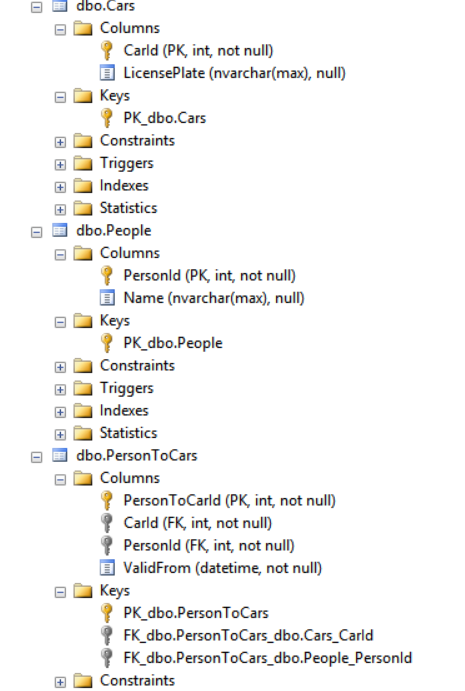Entity Framework Mapping relationship with Entity Framework Code First: One-to-many and Many-to-many Many-to-many: custom join entity
Example
I have to admit, I'm not really a fan of letting EF infer the join table wihtout a join entity. You cannot track extra information to a person-car association (let's say the date from which it is valid), because you can't modify the table.
Also, the CarId in the join table is part of the primary key, so if the family buys a new car, you have to first delete the old associations and add new ones. EF hides this from you, but this means that you have to do these two operations instead of a simple update (not to mention that frequent inserts/deletes might lead to index fragmentation — good thing there is an easy fix for that).
In this case what you can do is create a join entity that has a reference to both one specific car and one specific person. Basically you look at your many-to-many association as a combinations of two one-to-many associations:
public class PersonToCar
{
public int PersonToCarId { get; set; }
public int CarId { get; set; }
public virtual Car Car { get; set; }
public int PersonId { get; set; }
public virtual Person Person { get; set; }
public DateTime ValidFrom { get; set; }
}
public class Person
{
public int PersonId { get; set; }
public string Name { get; set; }
public virtual ICollection<PersonToCar> CarOwnerShips { get; set; }
}
public class Car
{
public int CarId { get; set; }
public string LicensePlate { get; set; }
public virtual ICollection<PersonToCar> Ownerships { get; set; }
}
public class MyDemoContext : DbContext
{
public DbSet<Person> People { get; set; }
public DbSet<Car> Cars { get; set; }
public DbSet<PersonToCar> PersonToCars { get; set; }
}
This gives me much more control and it's a lot more flexible. I can now add custom data to the association and every association has its own primary key, so I can update the car or the owner reference in them.

Note that this really is just a combination of two one-to-many relationships, so you can use all the configuration options discussed in the previous examples.
